Also elsewhere, in the course of a discussion of Haworth’s new/refurbished headquarters and its re-invented business vision, I introduced John Robinson, from the University of British Columbia, whose take on redesigning design and on its connection to matters of human activity and behaviours made more sense than any other single contribution to this inexpressibly complex debate I have so far heard. Essentially, he maintains that you can’t have sustainable policies, sustainable design, sustainable buildings or sustainable anything else without sustainable human behaviour. The estimable Ben Humphries, Associate at long-established ‘green architect’ Architype, agrees, having just completed 56 Southwark Bridge Road in south London, a new Creative Media Training Centre in an old Victorian library, on a site none more urban. It includes just about every eco-architectural move you can make in this day and age, but the architects politely hint at some, shall we say, frustration in the process of ‘user education’. You can build a super sustainable building, in other words, but it ain’t sustainable at all unless the users use it sustainably.
What’s my point? Three actually, upon all of which the foregoing has bearing. I respectfully draw your attention to 1) the work of Professor Jeremy Myerson and his team at the RCA’s Helen Hamlyn Centre (with research partners in Japan and Australia) on the Welcoming Workplace, generously assisted by Kinnarps; to 2) the publication by Unwired Ventures, one of the arms of Philip Ross’s Cordless Group, of The Unwired ‘Byte-Sized’ Guide to Sustainability in the Workplace; and to 3) a comparison of Herman Miller’s new all-singing, all-dancing Embody chair, claimed to give health to parts of the body you never knew existed, and Niels Diffrient’s prototype Diffrient Work chair for Humanscale, both of which were on view at Orgatec 08.
First, the Welcoming Workplace. The Helen Hamlyn Centre was set up to explore and promote the idea of ‘inclusive’ design at the time when it was first becoming abundantly obvious that design by and large ignored the increasingly dominant over-50 age group. Everyone knows by now – or should if they don’t – that by 2020 nearly half of the adults in the EU will be over 50. This trend is visible in nearly every country in the world except for some African nations. The Helen Hamlyn approach is not to design for older people, but to design environments and products that can be used by everyone, including older people. And they are currently promoting and exhibiting the results of their year-long Welcoming Workplace project (the Kinnarps showroom had an exhibition on Designers’ Saturday). You can find out all about it on their website, but suffice it to say here that, thank God, someone has at last come out with a piece of wisdom on office design that I think we all knew in our hearts but never got round to admitting, we were so eager to keep up with the newest and latest thinking on collaborative, flexible, knowledge-driven new ways of working.
The research, amongst older office workers (not decrepit, just not young), on three continents has led to the conclusion that everyone – including the young – needs at least three types of interior; spaces to concentrate, spaces to collaborate, and spaces to contemplate. Office design should therefore include all three; the office should be a place of variety, not one in which a single open plan (or cellular) model dominates; and thus the older generation of office workers – whose value, in a knowledge economy, is self evidently greater because if their experience – are not only accommodated but made to feel accommodated, which psychological benefit is more than half the battle.
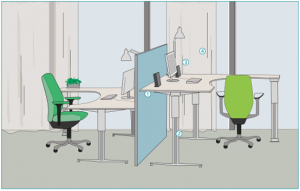
Recommendations for spaces to concentrate include a noise masking system, motorised height adjustable desks, task lights and available windows
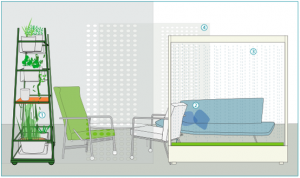
Recommendations for spaces to contemplate include an ‘office garden; a variety of furniture; a curtain of falling water to soothe the mind and purify the air; semi-transparent dividers which separate but do not isolate
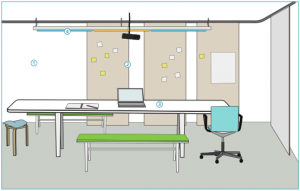
Recommendations for spaces to collaborate – the team ‘owns’ the space: an abundance of display space, digital and traditional; moveable and bench-style furniture; dynamic lighting
The WW project does not focus on sustainability in the environmental sense. But, crucially, it is entirely focused on behaviour and the environments that support those whose needs have not been so far met, and in no way does it alienate the younger workers. Its recommendations thus lead us to humane and therefore sustainable design.
The Unwired ‘Byte-Sized’ Guide to Sustainability in the Workplace, which also benefits from Kinnarps’ support, is something entirely different. It is a well written and well researched comprehensive guide to the overall environmental issues, to the ones that deal specifically with office buildings, to the legislative landscape in more than one country, to standards and regulations, and to the routes that occupying companies can take to reduce energy consumption, reduce costs, fulfil a corporate social responsibility agenda and otherwise compile a meaningful carbon reduction strategy. Crucially, it concentrates on existing buildings rather than new build, accounting for the issues in 98 – 99 per cent of buildings rather than dealing with construction techniques and materials for the one per cent in the design and build process.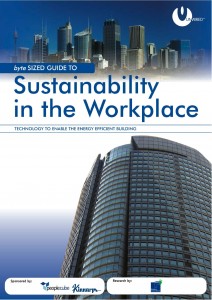 A useful reference for facility managers, architects and interior designers and indeed members of the board, not least because it also deals with the building management technologies that support and enable carbon reduction and energy efficiency measures. Further still – and this is the point – it comes round to individual environmental control and accountability, where it begins to overlap with the ideas behind Welcoming Workplace, and the ‘sustainable behaviour’ mentioned above. ‘With developments in information technology enabling greater integration between… building systems and more energy efficient use of the workplace,’ it says, ‘there is also the potential to provide individual staff members with the ability to control their own environment. As a result, staff are likely to benefit from greater comfort and higher productivity, and become more aware of their individual responsibility to reduce energy use.’ Sustainable and humane go together again.
A useful reference for facility managers, architects and interior designers and indeed members of the board, not least because it also deals with the building management technologies that support and enable carbon reduction and energy efficiency measures. Further still – and this is the point – it comes round to individual environmental control and accountability, where it begins to overlap with the ideas behind Welcoming Workplace, and the ‘sustainable behaviour’ mentioned above. ‘With developments in information technology enabling greater integration between… building systems and more energy efficient use of the workplace,’ it says, ‘there is also the potential to provide individual staff members with the ability to control their own environment. As a result, staff are likely to benefit from greater comfort and higher productivity, and become more aware of their individual responsibility to reduce energy use.’ Sustainable and humane go together again.
Last but not least, a quick note about the two major chair launches at Orgatec; Herman Miller’s Embody, the result of six years’ research and work, which is intended to reflect and support body movement to a far, far more detailed and responsive level than ever before. Miller apparently thinks that the impact on the market will be similar or greater than that of Aeron. Naturally, being from Herman Miller, the design includes a huge percentage of recycled and recyclable components, and as far as it goes all the possible environmental credentials are there.
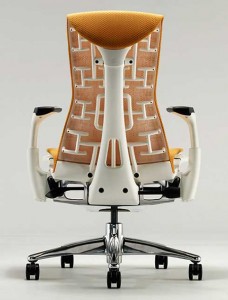
Herman Miller's Embody – very nice, but is it sustainable design?
But when you compare it with Diffrient’s ‘Diffrient’ work chair for Humanscale, only visible in prototype form at Orgatec, it rapidly becomes painfully clear which way office seating design should go. Little or no engineered adjustments – they are pretty much all automatic, which to be fair is true of Embody as well – eight major components (of course the components are made up of components, but nonetheless the simplicity of design and manufacture is astonishing) – and a list price point not far off a third of the Miller product. Both are humane design, but ask yourself which one is more truly sustainable. Great try Mr Miller, but I believe you’re looking in the wrong direction. Sorry!
www.architype.co.uk/southwark.html
www.hermanmiller.com/CDA/SSA/Product/0,,a10-c440-p271,00.html
www.humanscale.com (no info on the Diffrient chair as of Dec 08)
• concentrate include a noise masking system, motorised height adjustable desks, task lights and available windows
Recommendations for spaces to collaborate – the team ‘owns’ the space: an abundance of display space, digital and traditional; moveable and bench-style furniture; dynamic lighting
• Recommendations for spaces to concentrate include an ‘office garden; a variety of furniture; a curtain of falling water to soothe the mind and purify the air; semi-transparent dividers which separate but do not isolate
